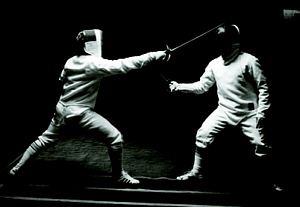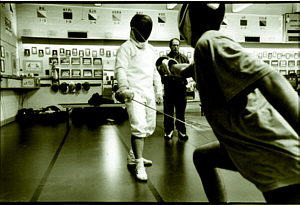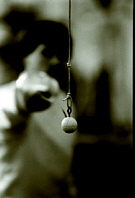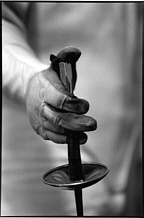|
|
"College-aged kids now, they're spoiled rotten," begins a typical
Oles speech. "They now have so many opportunities, the idea of
choosing one activity to concentrate on is beyond the pale." Ask
him what makes a good fencer, and he replies, "First, you have to
look at it as combat. It's a war out there. It's just you and
your opponent, no mommy, no daddy, no brothers, no sisters.
You've got to think, 'You SOB, I'm gonna kill you.' The American
male has been feminized, but you don't have to scratch very deep
to find that combative nature." He falls silent for a moment,
watching some of his charges going through their various drills
out on the practice floor, then muses, "We get guys in here who
scored 1400 on their college boards but can't find their fly in
the bathroom."
The fencers on his team take his gibes with patient good nature,
occasionally finding opportunities for verbal ripostes. He
clearly enjoys their company, no matter how much he grouses. One
day, two of them arrive with new and not necessarily well-advised
beards. "Is this a Samson thing?" Oles asks. "Because the chicks
don't care."
Says one fencer of his new facial hair, "It announces the
completion of puberty."
"You need a biology course," Oles replies.
Later, a visitor to practice watches a gawky kid at the far end
of the room. Oles has been laughing at how flaky this kid is, and
when asked for the young man's name, the coach gives a
surname.
"What's his first name?"
"I haven't a clue," Oles says, then grins. "He probably
couldn't
tell you."
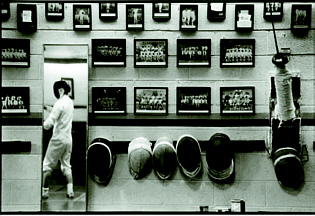 |
"Even a strong and lusty man without the
proper type of exercise cannot deliver blows with the power and
speed of one who is properly exercised."
-Giacomo diGrasse, 1570 |
Fencing is a fundamentally simple sport: two contestants square
off, each armed with a sword, and fight according to simple
rules. In a tournament, preliminary bouts are over when one
fencer scores five touches, what would be wounds in actual
combat. Elimination bouts require 15. The swords come in three
types: sabre, épée, and foil (win all three and
your team is
three-weapon champion). All are just short of three feet long;
the sabre and foil each weigh less than a pound, while the
épée
is heavier, around 27 ounces. Heritage has determined how each
weapon is employed. The sabre is derived from the cavalry sabre,
popularized by the Hungarians, so the fencer may both stab and
slash with it, and scores by striking the opponent's head or
upper body, those parts that were vulnerable for mounted
combatants. The épée derives from the dueling
sword, the épée de
combat, and the goal in a duel, at least a duel fought in
accordance with formal rules, was simply to draw the opponent's
blood, not necessarily inflict a mortal wound. Thus in
épée the
fencer scores by touching the opponent anywhere, including the
feet. Foil began as the fleuret, a practice weapon, used for
instruction by fencing masters; only a touch to the opponent's
torso gains points.
 |
| A newcomer to the team (top right)
practices various forms of attack on a member of the
varsity. |
Each weapon attracts a different personality. Sabre, with its
slashing pedigree, appeals to what Oles calls the "macho,
aggressive, football-wrestler me-kill-em personality."
ƒpée is "a
counter-puncher's weapon," requiring patience and cunning, since
a touch anywhere means a point. Foil, he says, is somewhere in
between. When a student first approaches him about joining the
team, Oles administers a questionnaire designed to help the coach
figure out which weapon will be most suitable. What are your
likes and dislikes? Your favorite sports? Do you see yourself as
aggressive or passive?
A newcomer learns the sport from the feet up. Writing in His True
Art of Defense, Giacomo diGrasse in 1570 said, "Firm footwork is
the fount from which springs all offense and defense." Before
rookies are allowed to even pick up a sword, they drill day after
day in how to rapidly move forward and back while maintaining the
balance that lets them attack or defend in a split second.
Fencing is the only combat sport in which there is no lateral
movement. In boxing, wrestling, karate, even sumo, combatants can
circle each other, move to the left or right. In fencing, there's
only forward and back, to and fro, attack or defend, the thrusts
and parries and ripostes occurring at stunning speed. It may look
like all it requires are reflexes and dexterity, but it demands
strength and conditioning as well. The legs especially must be
strong. And endurance is tested at tournaments in which an
athlete might compete in 10 or 15 bouts in a single day.
Ryan Schwerzmann, a junior psychology major and the team captain,
wrestled in high school. He says, "You wouldn't think it, but you
need more endurance for fencing than in a wrestling match. This
is the hardest sport I've ever participated in."
Schwerzmann had never fenced before college. Hopkins has a
tradition of creating its own fencers. The varsity assumes
responsibility for instructing and drilling newcomers, under the
critical eye of Oles. Matt Bouloubasis, the one who can cuss in
Greek, is a freshman physics major. By virtue of having fenced in
high school, he moved right to the varsity. He says, "We're a
closer team than anywhere else. We can make a good fencer here in
one or two years."
"Half of them aren't athletes when they come to us," Oles says.
"The ones who are athletes are used to the ball sports." Much of
what they learned in those sports is no help for fencing. Says
the coach, "We need to teach them how to walk."
 |
"Firm footwork is the fount from which
springs all offense and defense."
-Giacomo diGrasse, 1570 |
Oles first entered Hopkins in 1951 as a student. Lacking
direction, he left to serve in the Army, then returned to
Baltimore and studied piano full-time for three years at the
Peabody Conservatory. He finally got around to completing a
Hopkins psychology degree in 1968. At various times he has been a
construction superintendent, a radioisotope technician at a
Baltimore hospital, a piano teacher, and a taxi driver. Since
1970, he has made his living solely from fencing: coaching
various teams, working with fencing clubs, conducting camps and
workshops.
When Oles began coaching 42 years ago, Hopkins required students
to take physical education, and they could get out of it only by
participating in a varsity sport. Fencing had been a men's sport
at the school since 1891, but that didn't make it fashionable.
"Fencing was what you did if you couldn't do anything else," Oles
says. "It was lower than golf."
But Oles was a good fencer. He has been Maryland state champion
several times and fenced on the U.S. masters team that won the
world championship in London in 1970. He proved to be a fine and
dedicated coach as well. "In the early 1970s," he says, "I got
the guys together and said, 'You've got a choice: Stay where you
are, in the bottom third of the country, or schedule more meets,
practice year-round, and accomplish something.' They immediately
said, 'Okay.'"
The team gradually took over the room it once shared with Hopkins
aerobics classes and the pitchers from the baseball team. As a
tradition, each year's team provides some improvement to the
facility, which is good enough now to host a youth club, an adult
club, and many tournaments each year. (Hopkins hosted the NCAA
national intercollegiate championship in 1973.) The program's
history is on the walls: team pictures (including one from 1951,
in which Oles has more hair), photos of individual champions,
trophies and medals, posters from various tournaments. All around
the room, a series of pennants represents opponents, with
Hopkins's record against them over the years painted underneath
and updated when necessary. There are a lot of winning records on
the walls: 24-2 against the University of Virginia, 10-0 versus
Yale, 22-7 against William & Mary. Each year, the best Division
III teams qualify for the NCAA national championships, competing
in the same tourney against the big schools. Most years, Hopkins
is there.
Four years after Hopkins began admitting women students, Oles
founded a women's team in 1974, which became the university's
first varsity women's sport. ("We beat tennis by three months,"
Oles recalls.) The program nearly fell apart after some
organizational problems, but this year has regrouped under a new
coach, Jennifer Rolling '97, a recruiter in Hopkins Career
Planning & Development. The squad has only nine fencers, the
minimum required for fielding a team, with four freshmen and no
seniors, but it will compete with a full schedule this season.
Says Rolling of Oles, "Once he sees you are dedicated to fencing,
you are part of his family."
 |
| It's not all work: "The ones who
stay after two weeks are usually the ones who stay for four
years," says one veteran. |
Back in the fencing room, Oles dons padding and a mask and helps
train a beginner in attacking moves. The coach's legs are still
muscular, as are his right forearm and shoulder. Fencers tend to
develop disproportionate musculature; take a close look and you
have no problem discerning whether one of them is left- or
right-handed. And Oles is lightning quick. Schwerzmann, the
captain, says the coach can still defeat most of the team's
épée
fencers.
At practice, Oles likes to ride Schwerzmann about his hair.
"We call him 'Puff,'" Oles says. "Show us why."
"Do I have to?" Schwerzmann replies. Oles gives him a look, and
Schwerzmann surrenders, jutting his lower lip and directing a
puff of air to blow his hair out of his eyes. Schwerzmann later
says that the coach comes on strong with newcomers as a test.
Those who can't take it likely won't make good fencers. He
observes, "The guys who stay after the first two weeks usually
are the guys who stay for four years."
|

